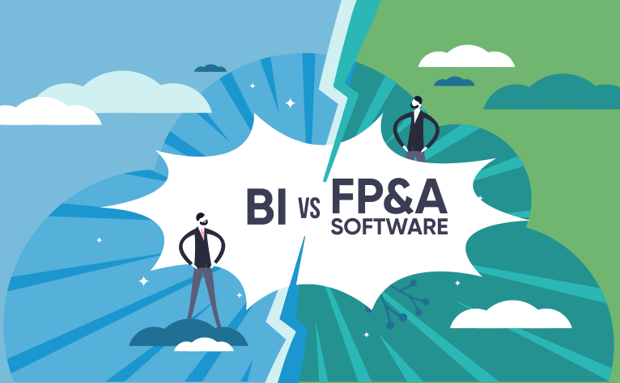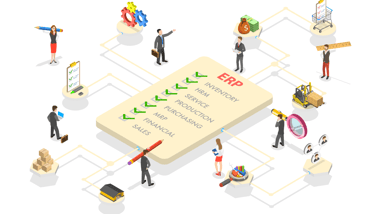Last month, in a special edition webinar, A Practical Comparison of BI and Cloud FP&A Tools for Digital Finance Teams, we sat down with Limelight’s CTO and Co-founder, Jade Cole, and asked about his extensive experience helping finance professionals navigate between these two planning tools. The questions, comparisons, and misinformation on this topic have been a popular theme for quite some time now. With Jade’s help, better clarity and understanding are now made available.
The terms CPM and Cloud FP&A are used interchangeably, with the latter being more relevant as the technology evolves. Let’s get into what our fireside chat with Jade revealed about the difference between BI and FP&A tools, when companies should look into implementing each, and the #1 thing companies must consider while searching for new technology.
With your experience over the past 25+ years, can you talk to us about how the financial landscape and the role of the Office of Finance have been impacted by big data over the past 10 years?
Today we have access to so much information that can no longer be analyzed by what you would call “conventional means”. If you think prior to the computer revolution, everything was done on paper. Ledgers were done with credits on paper, and it was all math that people could compute in their heads. That information was a lot smaller in volume than what we have now.
People can rate you in real-time on social media. An unhappy customer can post and share negative reviews on Twitter or Facebook, while a happy customer can give you a fantastic review on Yelp or Google, and that’s all happening at once. So, all these people with these different devices are now like an extrasensory network that's creating all this big data.
The office of finance is not immune to this. Advances in computing power and ease of data access mean much more information is available. This information is useful if we can make sense of it, know what drives our business and how it can help us make better decisions.
How would you describe the differences between BI and Cloud FP&A tools?
There are two main differences: the target audience for these tools and the use cases.
These are both broad topics, but from a technical perspective, BI is primarily a data distribution mechanism. These tools focus on taking information and disseminating it out in digestible formats: charting, graphing, and KPIs. A properly implemented BI solution visualizes strategic goals and how they are tracking based on their area of responsibility.
Whereas FP&A is more of an input and output mechanism that is typically more narrowly focused on problems related to the Office of Finance because that's usually where the planning function resides.
There is some overlap between the two applications. It's not uncommon for FP&A and BI tools to have some similar reporting and analysis capabilities. However, an FP&A platform is geared more toward a collaborative input and output and reporting solution within the planning function, versus BI which is used across the enterprise but offers more shallow information.
It’s important for people to understand that both BI and FP&A are not just pieces of technology they're also organizational disciplines. Buying a BI product won't make your data more useful or help you make better decisions unless you know what it is you're trying to measure and manage. Same as FP&A. If your planning process is manual and you want to automate it, you have to understand the objectives of your organization and how a tool will help achieve those.
What advice would you give to finance teams looking to automate their FP&A process? How can they determine whether a BI solution or an FP&A solution would be better for them?
Part of this is understanding what your needs are. Is the problem that, you have so much data that you can't figure out how to make better decisions? Or is the issue that, you want to perform more advanced planning and scenario analysis, but doing it in Excel takes so long that you just don't bother to do it?
Toward the beginning of the pandemic, banks and lenders asked businesses for all kinds of additional information. Businesses would turn over their standard set of financials to the lender, who would then say, “That's great but show me a 3-year cash flow projection showing a best and worst expected case scenario.” They want to see all these variations and being able to do that quickly is very hard if you're doing everything manually.
Finance teams were struggling to put this analysis together because they didn't have it and they hadn't thought of their business that way. But with an FP&A platform, for example, we can apply technologies to help automate and drive efficiency in creating these financial statements. So, in times like a pandemic, these organizations can be prepared.
When determining whether a BI or FP&A solution is right for you, first think about what goals you're looking to achieve, what problems you are looking to solve, or how you define that success criteria. Answering those questions is really going to help companies decipher between the two, and figure out which one you’re going to leverage first and a bit more.
What are some scenarios in which using a Cloud FP&A system might be more beneficial than a BI tool or vice versa?
Like I mentioned before, there is an overlap between these two systems. With an FP&A tool facilitating the forward-looking planning function, then that information can feed into the BI solution to disseminate your corporate targets down throughout the organization. We can see them as complementary technologies, and not that you must choose one or the other.
Especially a customer who's new to this and isn't as technical or doesn't know the industry as well, might not know the difference. They look at all the marketing material and they see screenshots and they say, “It looks the same to me!” But they don't grasp the difference that one of these is more of an input thing and one is more of an output thing, and it comes back to defining your goals and being able to articulate them.
With prospects, we sit down and listen to their concerns and say well that sounds more to me like an FP&A tool because you need to capture inputs; you need to consolidate information from different departments, and you need to do what-if analysis. If you're looking to be more of a reporting platform to disseminate information throughout the organization that is from other systems, maybe a BI tool is a better fit for that. But it's a one-way street with the BI tool. It's primarily output, so that is the main difference.
Part of the problem with data is that our ability to gather it has always exceeded our ability to analyze and understand it. As an organization grows, that data is going to become even more pertinent and that much harder to decipher, as it's hard to sift through the noise. Part of embracing tools is to understand what you're trying to achieve and then figuring out the tools that help you do that.






